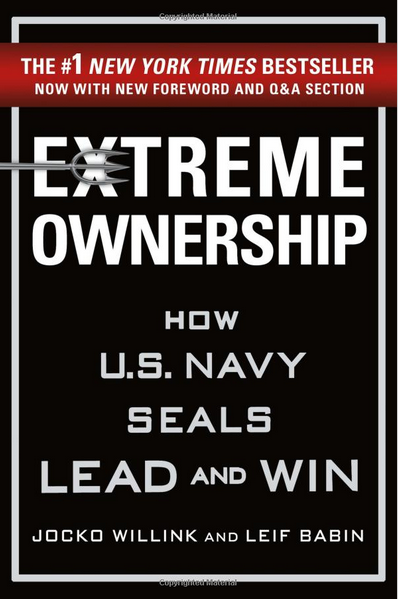When Navy SEALS write a book on leadership, you should pay attention. Extreme Ownership was sent to me by a friend and it took me a bit to actually read it, but once I did, I couldn’t put it down. In my consulting with churches, I have realized how applicable this book is when it comes to helping staff and volunteers really own their roles. There is plenty of data to show that when a team member has ownership, they are more deeply involved, stay longer, and produce better, long-lasting results. So, churches and non-profits alike can take the stories and leadership lessons from this book and bolster their effectiveness, one person at a time. The bottom line is extreme ownership in a church or non-profit simply makes a bigger impact.
The book is a series of stories based around a leadership concept. Jacko Willink and Leif Babin share the ups and downs of being a U.S. Navy SEAL and leading troops in war. Each chapter starts with a real scenario and unpacks the leadership lesson, then applies that lesson to a case study at a business they were consulting with later. Here are a couple of my favorite lessons.
Teams Rise and Fall on Leadership
In the second chapter called No Bad Teams, Only Bad Leaders, Jacko Willink tells his story of training for the U.S. Navy SEALS and how there were exercises with boat crews. The crews were competing against one another day after day, and one of the crews was standing out as the dominant crew, while another was clearly the lowest scorer time and again. But then the SEAL instructors had the leaders of these crews swap places. The only difference now was the leaders. So how would the two crews perform now?
o
Shockingly, the worst crew jumped to first, and the prior first place crew, now with the leader of the boat that was performing worst, finished second. The rest of the day, these two crews fought hard, but the crew of the previously worst team, continued to finish in the lead. Whats the principle? There are no bad teams, just bad leaders. Or as Jacko puts it
“Leadership is the single greatest factor in any teams performance. Whether a team succeeds or fails is all dependent on the leader. The leaders attitude sets the tone for the entire team. The leader drives performance – or doesn’t. And this applies not just to the most senior leader of an overall team, but to the junior leaders of teams within the team” (p. 49).
Empowering a Decentralized Team
In another chapter called Decentralized Command, Jacko tells a story of almost ordering a strike on a friendly position. Through an intense couple of minutes he asked for a re-check of a building number slated for an airstrike. When it was compared to what the map said, all those in the conversation realized that they almost blew up a building where many friendly U.S. military were holding. Because of a decentralized structure that empowers leaders to make decision on smaller tactical issues, he was able to monitor the bigger picture and help those he commanded avoid a gross blunder, saving lives in the process.
In one very enlightening paragraph, he says:
The proper understanding and utilization of Decentralized Command takes time and effort to perfect. For any leader, placing full faith and trust in junior leaders with less experience and allowing them to manage their teams is a difficult thing to embrace. It requires tremendous trust and confidence in those frontline leaders, who must very clearly understand the strategic mission and ensure that their immediate tactical decisions ultimately contribute to accomplishing the overarching goals. Frontline leaders must also have trust and confidence in their senior leaders to know that they are empowered to make decisions and that their senior leaders will back them up. (p 171)
Other tidbits this chapter also covers are the basics of managing people, spelling out the capacity of a normal manager is 6-8 direct reports.
It also talks of the importance of everyone owning their responsibilities stating “If frontline leaders do not understand why, they must ask their boss to clarify the why.” (p. 183)
Serious About Ownership
Over and over again in the book, I was reminded how effective leaders lead themselves first, owning every aspect of what they touch and are responsible for. This means taking responsibility if there is a miscommunication from the top down to them, because they may have not asked another clarifying question. It also means the leader at the top takes responsibility if a team does not perform. They may have not given clear direction, or been sloppy at empowering and then getting out of the way. That does seem extreme.
What about a church?
There are many great lessons in this book, but a couple I would point out for churches are:
Keep the mission clear and simple. Sometimes good things distract from the unique best thing at that moment. “Simplifying as much as possible is crucial to success” (p 140). Events, outreaches, retreats, and other single initiatives should have single goals that compliment the larger goal. And everyone who is helping make that endeavor happen should know what that is. Simple and clear.
Leaders should embrace lessons learned through failure. And a leader needs to be humble enough to acknowledge what they can learn from. As Jacko put it “The best leaders are not driven by ego or personal agendas. They are simply focused on the mission and how best to accomplish it” (p. 8). This also translates to being okay with not knowing everything. It is entirely okay to empower someone else to lead and be the expert in something. If a leader can’t do that in a church…well…failure is probably more frequent then it should be.
Take the next step with iLLUME Consulting:
We would love to talk with you and discuss any leadership challenges you may have. Contact us or request a free 30-minute video meeting to chat.


